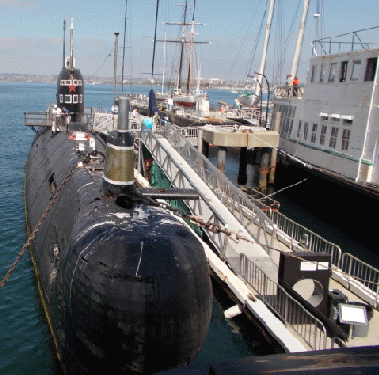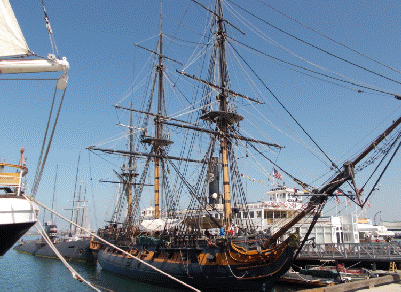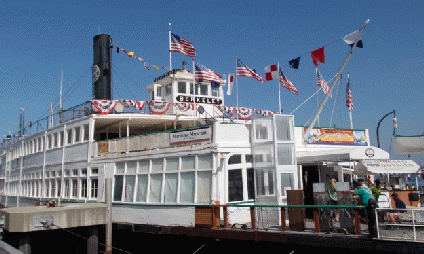

`If you are interested in the sea and ships, and almost everyone is, then a visit to San Diego's Maritime Museum is almost a necessity. Here one can glimpse what life was like at sea both in modern and historic times and the major role San Diego Bay has played in California's history.
Two additions to the modern era are the USS Dolphin, a Navy research submarine and the Soviet B-39. a Fox Trot Class submarine used during the Cold War. It had a crew of 78 men, was diesel ;powered and often patrolled for months at a time.

The Dolphin was developed in the last part of the last century for naval research and established many 'firsts' including the deepest dive, a record that still holds. It also set the record for the deepest launch of a torpedo as well as earliest laser communication. Moving through the boat means squeezing past small spaces and instruments, gadgets, dials, pipes and wines that immerse one.
One of the historic ships is H.M.S. Surprise. The ship was used in the making of the Academy Award winning film "Master and Commander."
The vessel is a replica of the H.M.S. Rose and has enjoyed a colorful history. The Rose was an English frigate that played a significant part during the Revolutionary War causing the Colonists a good deal of mischief. It was among His Majesty Ships that forced General Washington from New York.
A new H.M.S. Rose was built in Nova Scotia in 1970 and was used in historical events as well as training for future seamen. Fox Studios purchased the ship for the filming of Master & Commander making suitable changes to aid in filming.
Inspecting H.M.S. Surprise from bowhead to stern was a must for this Writer who had read both Jack O'Brian books on which the film was based. Signs posted on the bulkheads tell the story of what life was like on sailing ships during the 18th century especially Navy ships which required over twice the usual number of crewmen. Also on display is the clothing worn by seamen and officers as well as mess utensils.

Besides the H.M.S. Surprise three other historic vessels are afloat at the Museum: the 1898 Ferryboat 'Berkeley'; the 1863 sailing ship 'Star of India' and the 1904 Steam Yacht, 'Medea'.
The 'Star of India' is a full rigged Bark that made some 21 voyages around the globe. In its long career the ship, one of the earliest iron-hulled ships to be built, was a merchantman with voyages between Britain and India. Later it took emigrants from Britain to New Zealand. Some 400 at a time. Then she hauled cargoes of timber, coal and sugar in the trans-Pacific trade.
Now the 'Star of India' is in the Guinness Book of Records as the oldest vessel in the world still sea worthy and regularly, on a yearly bases, puts out to sea once again.
From Captain's Cabin astern to the seamen's "foc`sle" at the bow a friendly Docent took this writer on a personal tour of the vessel that started service in 1863 as 'Enterpe', named for the Greek goddess of music. Only later when the vessel was used in the Alaskan salmon fishery was it renamed the 'Star of India'.
The Ferryboat 'Berkeley' is ideal for a museum with its wide decks and includes a fine exhibition of oil paintings depicting maritime history in war and peace. And its steam driven engines and boilers are there to see close-up. It saw service starting in 1898 operating in San Francisco Bay. Here one finds exhibitions like one that market the Bicentennial of the War of 1812. Wonderful oil paintings depict some of the sea battles between ships of the young Republic and the Royal Navy.
We spent much time in a special art gallery collection of Duncan Gleasey, one of California's premier marine theme painters.
The Steam Yacht 'Medea' also has a unique history both as a pleasure craft and being used for naval work in both World Wars. It is moored next to the 'Berkeley' and again invites inspection and retrospection of another age.
There is always a reason to return to this museum. In progress is the reconstruction of the San Salvador, Juan Rodriguez Cabrillo's flagship which discovered San Diego bay for Europeans ion September 24, 1542. This full sized replica of a Spanish galleon can currently be seen just a few miles from the Museum and a visit to see 1540 style ship construction is included in a Museum ticket price.
For hours and information on the Maritime Museum located at 1492 N. Harbor Drive call 619 234-9153, web wwwsdmaritime.org.


Graphic Design by Impact Graphics